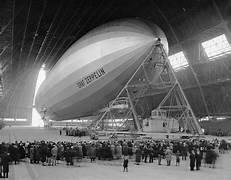On October 26, 1933, the United States witnessed a historic event as the German airship Graf Zeppelin made its maiden voyage to America. The arrival of the Zeppelin marked a significant milestone in aviation history and captivated the imagination of people around the world. The Graf Zeppelin, named after the German Count Ferdinand von Zeppelin, was a massive airship that was renowned for its luxurious accommodations and advanced engineering. It was one of the most iconic and successful airships of its time, symbolizing the possibilities and excitement of air travel. The journey of the Graf Zeppelin to the United States was a momentous occasion. Departing from Friedrichshafen, Germany, the airship embarked on a daring transatlantic flight, covering a distance of over 6,000 miles. The voyage captured the attention of people worldwide, as it demonstrated the potential of airships as a means of long-distance travel. The Graf Zeppelin's arrival in the United States was met with great enthusiasm and excitement. The airship made stops in various American cities, including Chicago and Los Angeles, where it attracted massive crowds eager to catch a glimpse of this marvel of engineering. The airship's visit to the United States showcased the growing interest and optimism surrounding the future of aviation. The Graf Zeppelin's journey also had significant implications for international relations. In the aftermath of World War I, Germany was subject to restrictions on military aviation. However, the Graf Zeppelin's successful transatlantic voyage demonstrated Germany's prowess in civilian air travel and helped to rebuild the country's reputation in the aviation industry. The airship's visit to the United States also fostered cultural exchange and diplomacy. It provided an opportunity for Americans to experience firsthand the German engineering and innovation that had gone into the creation of the Graf Zeppelin. The airship's crew, including Captain Hugo Eckener, played a crucial role in promoting goodwill between the two nations. The voyage of the Graf Zeppelin to the United States also highlighted the potential of airships as a mode of transportation. At the time, airships were seen as a promising alternative to traditional aircraft, offering a comfortable and luxurious travel experience. The Graf Zeppelin's successful transatlantic journey further fueled the optimism surrounding the future of airship travel. However, the era of airships was short-lived. The Hindenburg disaster in 1937, when the airship caught fire and was destroyed while attempting to dock in New Jersey, marked a turning point in the history of airship travel. The tragic incident led to a decline in public confidence in airships and ultimately spelled the end of the Zeppelin era. Despite its eventual demise, the Graf Zeppelin's voyage to the United States on October 26, 1933, remains a significant event in aviation history. It showcased the potential of airships as a means of long-distance travel, fostered cultural exchange and diplomacy, and symbolized the excitement and optimism surrounding the future of aviation. The Graf Zeppelin will always be remembered as an iconic symbol of a bygone era of air travel.
26 Oct, 1933 U.S.A. Graf Zeppelin
